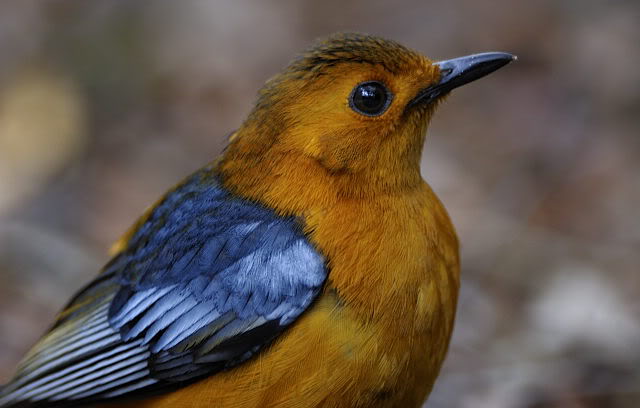White-throated Robin-Chat
Posted: Fri Mar 21, 2014 1:31 pm
602. White-throated Robin-Chat Cossypha humeralis (Afrikaanse Witkeeljanfrederik)
Order: Passeriformes. Family: Muscicapidae

Description
Length 16-18 cm, weight 20-29 g.The only robin in the region with a white wing bar and a white throat and breast. The upperparts are mostly slate-grey, with the rump being orange. The face and neck are black, and the eyebrow is white. It has a rufuos tail with a dark centre and black tips to all the feathers. Sexes are alike.
Juveniles are sooty coloured, heavily mottled with buff and brown above and below, and lack the white wingbar.
Distribution
Endemic to southern Africa, occurring from Zimbabwe, southern Mozambique and south-eastern Botswana to north-eastern South Africa.
Habitat
Dry thornveld, thickets and riverine scrub.
Diet
It mainly eats insects supplemented with fruit and small vertebrates, doing most of its foraging on the ground.
Breeding
The nest is an open cup built of dead leaves and dry grass with a rim of twigs, lined with coarse material such as tendrils, leaf fragments, midribs and stalks. It is typically placed on the ground, such as in a hollow in a tree stump, at the base of a vine, or even in an old pot or tin. Egg-laying season is from September-January, peaking from October-November. Two to three eggs are laid, which are incubated solely by the female for about 14-15 days. The chicks are fed by both adults, leaving the nest after about 13-14 days, but remaining dependent on their parents for about 6-7 more weeks.
Call
Song a series of high-pitched melodious phrases, commonly incorporating mimicry. Alarm call a repeated seet-cher, seet-cher. Listen to Bird Call.
Status
Locally common endemic.
Order: Passeriformes. Family: Muscicapidae

Description
Length 16-18 cm, weight 20-29 g.The only robin in the region with a white wing bar and a white throat and breast. The upperparts are mostly slate-grey, with the rump being orange. The face and neck are black, and the eyebrow is white. It has a rufuos tail with a dark centre and black tips to all the feathers. Sexes are alike.
Juveniles are sooty coloured, heavily mottled with buff and brown above and below, and lack the white wingbar.
Distribution
Endemic to southern Africa, occurring from Zimbabwe, southern Mozambique and south-eastern Botswana to north-eastern South Africa.
Habitat
Dry thornveld, thickets and riverine scrub.
Diet
It mainly eats insects supplemented with fruit and small vertebrates, doing most of its foraging on the ground.
Breeding
The nest is an open cup built of dead leaves and dry grass with a rim of twigs, lined with coarse material such as tendrils, leaf fragments, midribs and stalks. It is typically placed on the ground, such as in a hollow in a tree stump, at the base of a vine, or even in an old pot or tin. Egg-laying season is from September-January, peaking from October-November. Two to three eggs are laid, which are incubated solely by the female for about 14-15 days. The chicks are fed by both adults, leaving the nest after about 13-14 days, but remaining dependent on their parents for about 6-7 more weeks.
Call
Song a series of high-pitched melodious phrases, commonly incorporating mimicry. Alarm call a repeated seet-cher, seet-cher. Listen to Bird Call.
Status
Locally common endemic.
 © Bushcraft
© Bushcraft © leachy
© leachy
 © Flutterby
© Flutterby © Dewi
© Dewi © Duke
© Duke © BluTuna
© BluTuna
 © Dewi
© Dewi © Duke
© Duke
